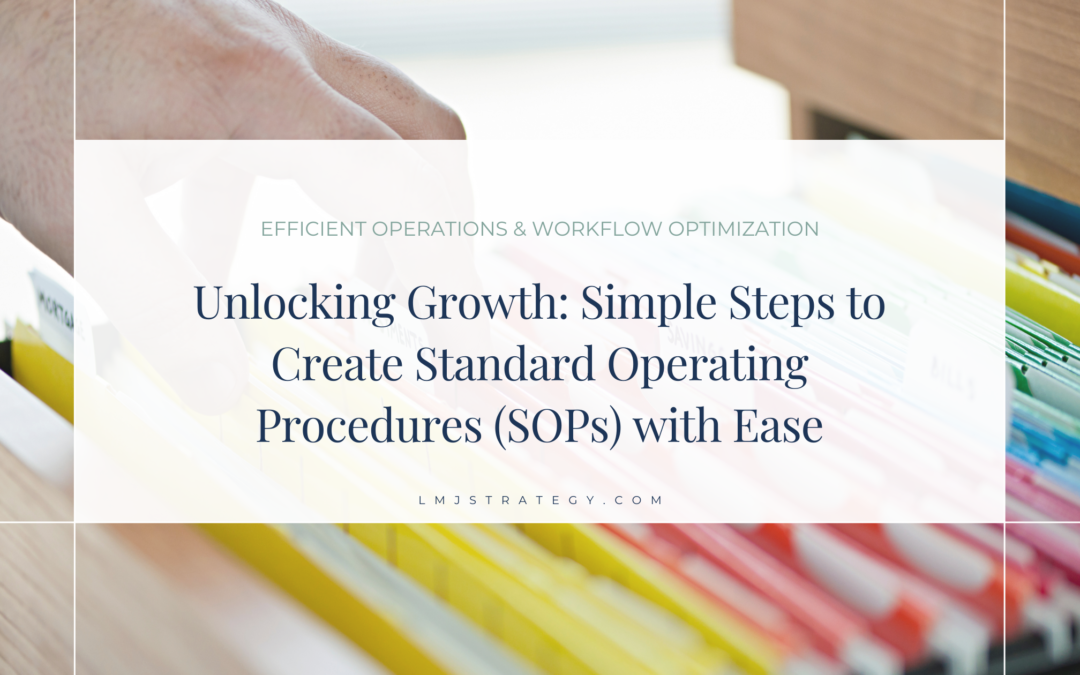Let’s face it: the thought of creating Standard Operating Procedures (SOP) might make your eyes glaze over. But what if I told you they could be critical to transforming your business? SOPs aren’t just about ticking boxes. They’re about giving your team the autonomy they crave, holding everyone accountable, and building trust.
Imagine a business environment where your team doesn’t just follow processes but actively engages with them, questioning and improving as they go, creating a more efficient and adaptable system. When done right, SOPs can be engaging, fun, and a catalyst for growth. Ready to see how this transformation can happen for you?
Transforming Overwhelm into Opportunity with SOP Documents
Feeling overwhelmed by daily operations is a common challenge for many business owners. The good news is that SOPs can transform that chaos into clear steps forward. These documents aren’t just about writing things down step-by-step. They’re about creating a framework that empowers you to operate autonomously and efficiently. By having clear, accessible guidelines, you reduce the mental load, allowing everyone to focus on innovation and growth.
SOPs provide the structure needed to streamline operations and foster growth. They give you the freedom to delegate with confidence, knowing that whatever you choose to do, you have access to the resources needed to succeed. Within a team environment, this autonomy fosters accountability and trust, as everyone understands their role and the expectations.
The great thing about SOPs is that they are living documents, evolving with your business to continually improve processes and adapt to new challenges. They are the key to unlocking a more streamlined, dynamic, and resilient business.
Getting Started with Documenting Your Processes
Creating SOPs is simpler than you might think. With a straightforward process, you can quickly and easily capture your workflows without adding much to your workload. Here’s how to get started:
- Capture the Process: Begin by capturing your process in a transcript. You can achieve this by typing up a “brain dump,” using a voice recorder, or recording with Loom. I recommend using a voice recorder as it’s both free and hands-free, allowing you to focus on the task while narrating each step.
- Refine with AI: Once you have your transcript, use AI tools like ChatGPT or SintraAI to transform it into a clear, organized list of steps. You can start with a simple prompt such as: “Please create a list of procedural steps from this transcript, organized in order of operations.”
- Save to a Document: After refining your steps, save each SOP as an individual document. Ensure it is titled clearly, such as “How to Onboard a New Client,” so it’s easily recognizable.
Organizing and Creating an SOP Database
Once you’ve started creating SOPs, organizing them in a central repository is crucial for easy access and management. Here are some tips on how you can set this up:
- Use a Spreadsheet or Database Tool: Start with a basic spreadsheet, adding a row for each SOP. As your needs grow, consider transitioning to a more robust tool like AirTable, or ClickUp. These platforms offer advanced features such as filters and search functions, making it easier to locate and update SOPs as needed.
- Categorize and Tag: Organize your SOPs by assigning categories and tags. Categories such as “Client Management” or “Operations” allows you to filter SOPs by department. Tags such as “WordPress” or “Safety” allow you to narrow down even further. This systematizes your SOPs and enhances searchability, especially when using database management tools that support filtering and sorting.
- Regular Updates: Keep your SOPs current by scheduling regular reviews. If you’re using a task or project management tool like ClickUp, set reminders to review SOPs on specific dates by adjusting due dates in advance.
By implementing these steps, you’ll create a comprehensive and adaptable SOP management system that supports your business’s efficiency and growth.

Common Mistakes to Avoid
Mistakes happen, and that’s okay! We all make them. To help you navigate the process of creating SOPs without added frustration, here are some common pitfalls to watch out for:
- Documenting Everything at Once: This is a key one to avoid! You don’t need to document all of your processes this week. Take your time. Start small, focusing on 2-3 processes per week at most. Once you get the hang of it, you can determine what cadence works best for you in the long run.
- Over-Complicating the Process: Keep it simple. Creating SOPs should be straightforward and easy to follow. Their goal is to help you, not confuse you, so simplify whenever possible.
- Neglecting Regular Reviews: Processes change, and so does technology. A simple “click the link in the upper left corner” could change to finding a link in a dropdown menu. Be sure to schedule periodic check-ins to keep SOPs accurate and up to date.
Remember, SOPs are living documents! They’re not meant to be set in stone but rather grow with you and help your business succeed. Don’t hesitate to adjust your approach to creating them as you discover what works best for you and your business.
Pro Tip: Once you’re comfortable with the process, create an SOP for how to document SOPs. This way, when you grow and bring in a new team member, they can document any new processes they perform as well.
Real-Life Success Story
Recently I was working with a client in one of my Focus and Flow Sessions. She was overwhelmed by a new workload during a restructuring process. She was juggling numerous tasks and felt the pressure of having everything thrown on her plate. As no one else knew how to accurately complete the tasks, she was additionally tasked to create documentation for the entire organization.
She knew documentation was essential. But with her packed schedule, she couldn’t figure out how to make the time to complete it.
During our session, we walked through my documentation process and the workflow she was looking to document. It was clear that she was so overwhelmed, she was struggling to even identify the steps in her overall process. We walked through it together, and with some guided questions, we were able to break it down into manageable steps. Her demeanor visibly shifted. What once seemed insurmountable became manageable. The task was now clear, and documenting it into an SOP wasn’t nearly as daunting as it originally seemed.
This newfound understanding reduced her stress and allowed her to manage her workload more effectively. She quickly started creating simple SOPs to start, and was able to delegate to other team members. This freed her to focus on what was truly important and allowed her to continue documenting other processes that needed to be delegated as well. For her, SOPs weren’t just a static requirement, but a dynamic tool that helped her succeed. It meant handling her tasks more efficiently and having the peace of mind that she could delegate or adjust processes as needed. It was a powerful reminder that with the right approach, SOPs can truly be a catalyst for change, fostering growth and reducing overwhelm.
Recommended Tools for SOP Creation
Choosing the right tools for creating and managing SOPs is crucial, but remember, they’re only as effective as the person using them. While I’ve listed some of my favorites below, it’s important to find what works best for you and your business. Over the years, I’ve created and managed SOP databases across various platforms, tailoring each to fit specific needs.
- Voice Recording Apps: I often use the talk-to-text feature on my iPhone, speaking directly into an email or my AI platform for quick documentation. This method is simple and effective for capturing thoughts on the go.
- Screen Recording Software: Loom is an excellent tool for visually recording steps alongside audio narration and transcripts. It’s particularly useful for remote or hybrid teams with more than two people. While Loom offers a free version, consider upgrading when your business scales to fully leverage its capabilities.
- AI Platform: Both Sintra and ChatGPT AI platforms are fantastic for creating SOP documentation. I’ve used them extensively for various projects. If you’re just starting out, the free version of ChatGPT is a great place to begin.
- Database Management: Managing SOPs requires a reliable system. My top picks are ClickUp, and AirTable, each offering free versions with robust features. Explore their capabilities to find the best fit for your needs. In the meantime, a basic spreadsheet can serve as a simple starting point.
Whether you’re just starting out or looking to refine your existing processes, these tools can help streamline your workflow and enhance efficiency.
Quick Steps to Get Started Creating SOPs for Your Business
Getting started with SOPs is all about choosing the right first step.
Begin by identifying a task that you perform frequently and know well. This should be something routine but essential to your operations, like creating a new client folder or sending a template email to a new client. The key is to select a task that is straightforward enough to document easily but impactful enough to make a difference once streamlined.
By starting with a familiar task, you’ll gain confidence in the documentation process and begin to see the benefits of having clear, structured procedures. This approach not only simplifies your operations but also sets the stage for more comprehensive process documentation as your business grows.
REady to TAckle your SOP Challenges?
If you’re feeling stuck trying to clarify which processes to document or struggling to break them down into manageable steps, you’re not alone. Perhaps you need a database but can’t decide which platform is best, or you know the platform but aren’t sure how to set it up effectively. These challenges can be daunting, but you don’t have to face them alone.
A personalized discovery session can provide the clarity and direction you need. Together, we’ll identify your unique needs, simplify complex processes, and find the right tools to support your business growth. Book your free 15-minute discovery call today and take the first step toward a more organized and efficient business.

